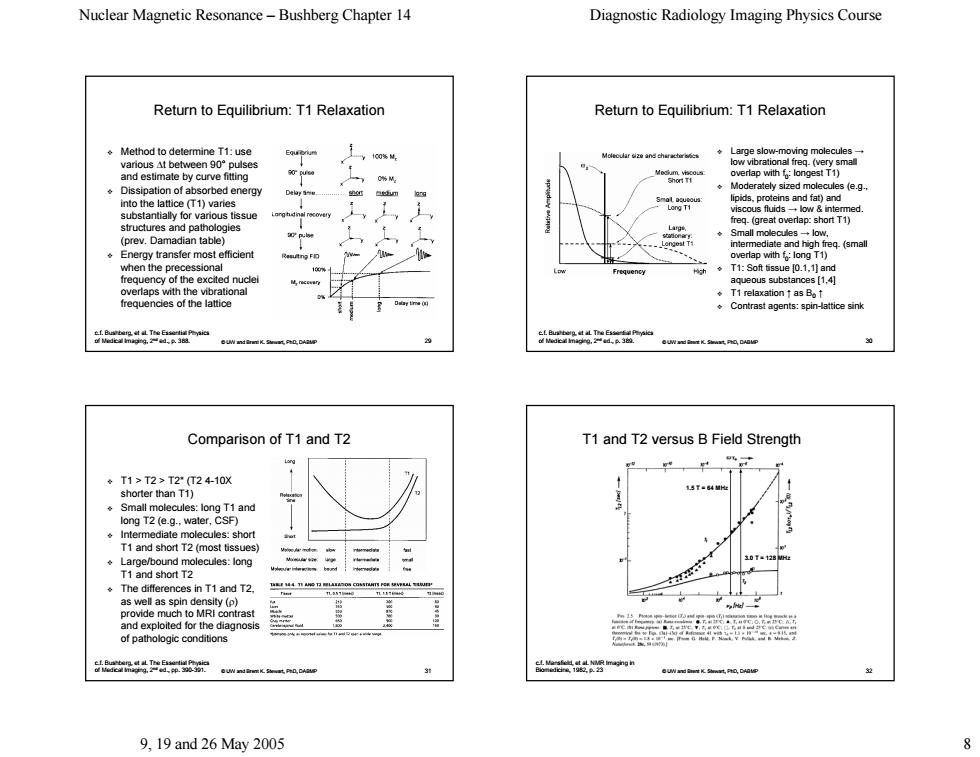正在加载图片...

Nuclear Magnetic Resonance-Bushberg Chapter 14 Diagnostic Radiology Imaging Physics Course Return to Equilibrium:T1 Relaxation Return to Equilibrium:T1 Relaxation .Method to determine T1:use y10%M Large slow-moving molecules- various At between 90pulses and estimate by curve fitting O%M: ap Dissipation of absorbed energy into the lattice (T1)varies lipids.pro s(. s and fat)and substantially for various tissue viscous fluidslow intermed. structures and pathologies freq-(great overlap:short T1) (prev.Damadian table) d how. .(small .Energy transfer most efficient overlap with f:long T1) when the precessional T1:Sof sissue [0.1.1]and frequency of the excited nuclei aqueous substances [1,4] ◆T1 relaxation as B.t Contrast agents:spin-lattice sink Comparison of T1 and T2 T1 and T2 versus B Field Strength ◆T1>T2>T2(T24-10x 15T84 shorter than T1) .Small molecules:long T1 and long T2 (e.g.,water,CSF) .Intermediate molecules:short T1 and short T2(most tissues) .Large/bound molecules:long T1 and shod T2 .The differences in T1 and T2. as well as soin density (o provide much to MRI contrast and exploited for the diagnosis of pathologic conditions 24e auW国nt K.Smat Pto,DAUP 9,19and26May2005 Nuclear Magnetic Resonance – Bushberg Chapter 14 Diagnostic Radiology Imaging Physics Course 9, 19 and 26 May 2005 8 © UW and Brent K. Stewart, PhD, DABMP 29 Return to Equilibr Return to Equilibrium: T1 Relaxation Method to determine T1: use Method to determine T1: use various various ∆t between t between 90° pulses and estimate by curve fitting Dissipation of absorbed energy Dissipation of absorbed energy into the lattice (T1) varies into the lattice (T1) varies substantially for various tissue substantially for various tissue structures and pathologies structures and pathologies (prev. Damadian table) (prev. Damadian table) Energy transfer most efficient Energy transfer most efficient when the precessional when the precessional frequency of the excited nuclei frequency of the excited nuclei overlaps with the vibrational overlaps with the vibrational frequencies of the lattice c.f. Bushberg, et al. The Essential Physics of Medical Imaging, 2nd ed., p. 388. © UW and Brent K. Stewart, PhD, DABMP 30 Return to Equilibr Return to Equilibrium: T1 Relaxation Large slow-moving molecules moving molecules → low vibrational freq. (very small low vibrational freq. (very small overlap with f overlap with f0: longest T1) : longest T1) Moderately sized molecules (e.g., Moderately sized molecules (e.g., lipids, proteins and fat) and lipids, proteins and fat) and viscous fluids viscous fluids → low & intermed. low & intermed. freq. (great overlap: short T1) freq. (great overlap: short T1) Small molecules Small molecules → low, intermediate and high freq. (small intermediate and high freq. (small overlap with f overlap with f0: long T1) : long T1) T1: Soft tissue [0.1,1] and T1: Soft tissue [0.1,1] and aqueous substances [1,4] aqueous substances [1,4] T1 relaxation T1 relaxation ↑ as B0 ↑ Contrast agents: spin-lattice sink c.f. Bushberg, et al. The Essential Physics of Medical Imaging, 2nd ed., p. 389. © UW and Brent K. Stewart, PhD, DABMP 31 Comparison of T1 and T2 T1 > T2 > T2* (T2 4-10X shorter than T1) shorter than T1) Small molecules: long T1 and Small molecules: long T1 and long T2 (e.g., water, CSF) long T2 (e.g., water, CSF) Intermediate molecules: short Intermediate molecules: short T1 and short T2 (most tissues) T1 and short T2 (most tissues) Large/bound molecules: long Large/bound molecules: long T1 and short T2 The differences in T1 and T2, The differences in T1 and T2, as well as spin density ( as well as spin density (ρ) provide much to MRI contrast provide much to MRI contrast and exploited for the diagnosis and exploited for the diagnosis of pathologic conditions c.f. Bushberg, et al. The Essential Physics of Medical Imaging, 2nd ed., pp. 390-391. © UW and Brent K. Stewart, PhD, DABMP 32 T1 and T2 versus B Field Strength T1 and T2 versus B Field Strength c.f. Mansfield, et al. NMR Imaging in Biomedicine, 1982, p. 23 1.5 T = 64 MHz 3.0 T = 128 MHz